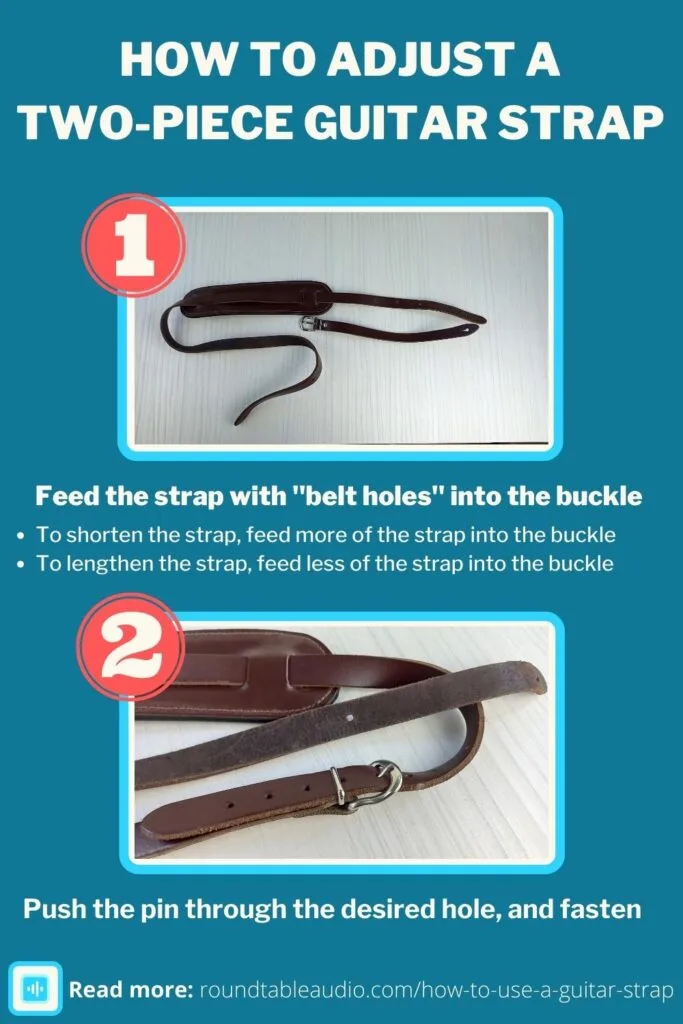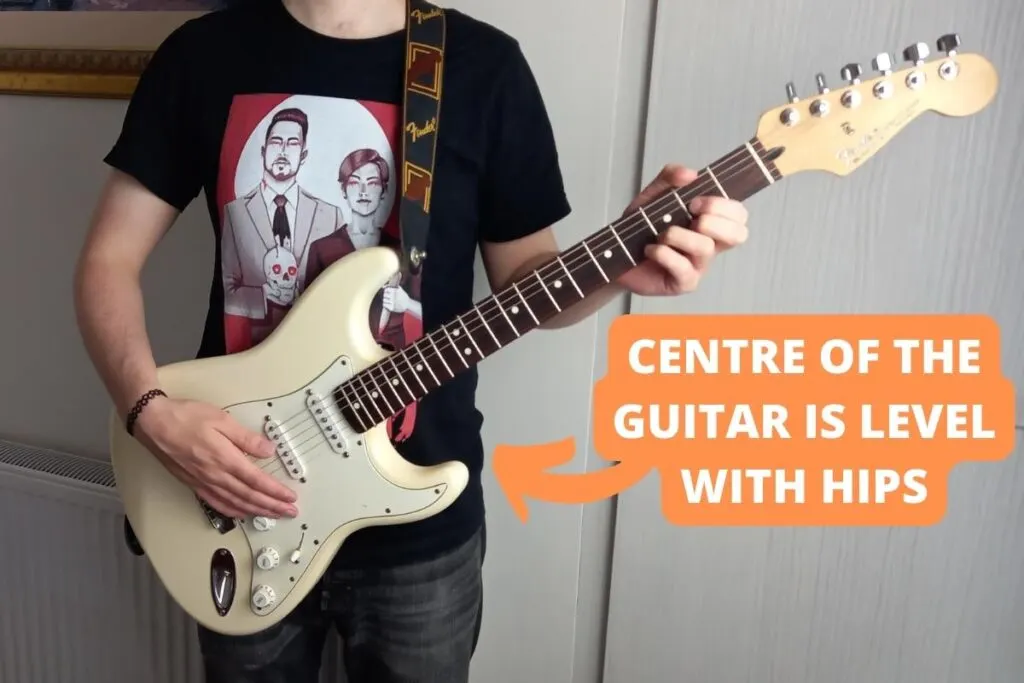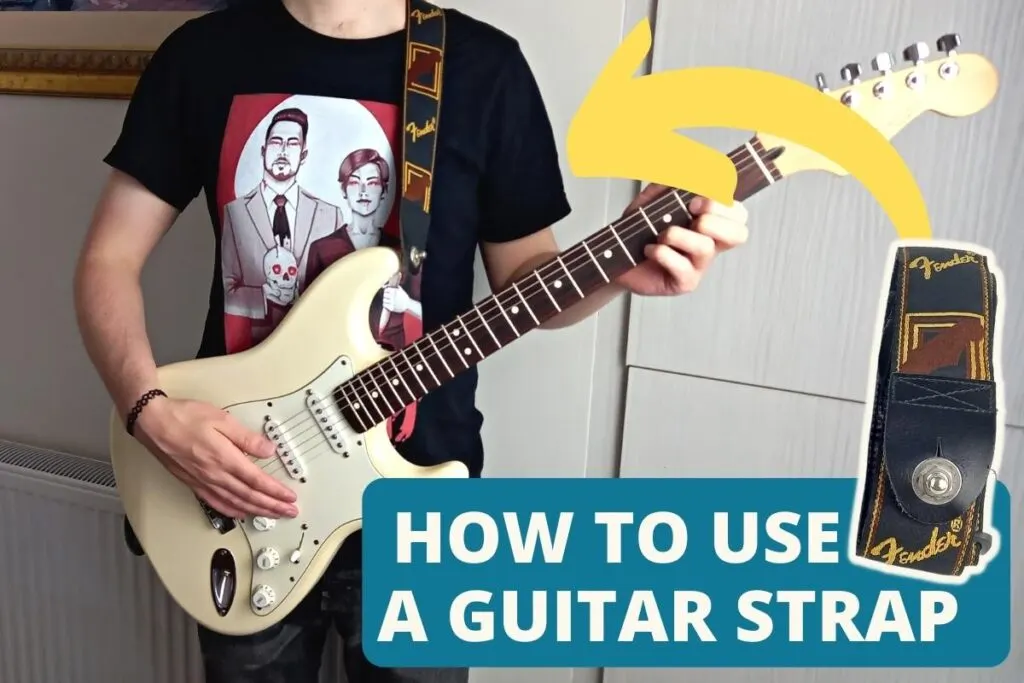A guitar strap is the lifeline between your guitar, gravity, and the ground. It’s important to know how to use a guitar strap to properly prevent any damage from coming to your beloved guitar (and any embarrassment for yourself!).
When used correctly, a strap should feel like it’s a natural extension of the guitar, and you should almost be able to forget that it is there. Let’s investigate the most critical factors in using a guitar strap and how it should be used.
How to attach a guitar strap
Every guitar strap has two buttonholes, one on each end. These buttonholes match the two strap pins located on your guitar’s body: one near the neck, and the other by the bridge.

Attaching a guitar strap to a guitar’s body is as simple as slipping the strap pins through the buttonholes. The patterned side of the strap should be facing outwards, and the side with the buckle should be attached to the bridge. The weight of your guitar’s body will keep the strap in place to keep your guitar from falling.
However, there are two weaknesses to using only the strap pins and buttonholes.
- Wear and tear will cause the buttonholes to grow weaker and bigger. As you remove and re-attach the guitar strap, the buttonholes on the strap will eventually get worn out and weak. This will cause your guitar to slip out of the strap and fall easily.
- Gravity only works one way: down. As long as your guitar is hanging in the strap, the strap pins and buttonholes should do their job and keep your guitar safe (unless, like in the previous point, they’re worn out). But things can get more complicated as you move around on stage. The more your guitar moves, it’s more likely to fall out of the strap.
But, both of these problems can be solved quickly, easily, and cheaply. How? With strap locks.
Strap Locks
Strap locks are the perfect solution to ensure that your guitar strap won’t suddenly lose its grip on the guitar. They work by securely locking your strap against your guitar by replacing your existing strap pins with a special mechanism.
They’re simple, inexpensive devices that are incredibly easy to install.
I’ve written a full, step-by-step guide on how to install strap locks that I recommend following to keep your guitar safe and secure.

Personally, I’ve had my guitar fall out of its strap before (including one time on stage!). Strap locks will not only save you from an embarrassing situation, but also protect your beloved guitar from damage. If you’re using a guitar strap for any reason: use strap locks.
How to adjust a guitar strap
Adjusting a guitar strap for a comfortable fit is crucial. Just like you don’t want your guitar to come loose and go crashing down, you also want it to be at a comfortable playing height. The shorter your guitar strap is, the height up your guitar will be. Likewise, the longer your strap is, the lower your guitar will be.
There are two basic guitar strap designs that are adjusted in different ways: the buckle design, and the two-piece design.
Buckle design
The buckle design on a guitar strap is similar to how the straps on a backpack work. The guitar strap is a single unit that is fed through a plastic buckle. One end makes a loop and feeds back to the buckle’s middle bar, which is used to change the length of the strap. The design makes it so that you can simply increase or decrease the strap length by sliding the buckle to either side of the strap.
To shorten a buckle guitar strap, feed the longest side of the strap into the buckle to create a “bump”. Then, hold the buckle and pull the strap from the shorter side. To lengthen the strap, feed the shorter side into the buckle.

The buckle design is commonly used because it is simple, effective, and inexpensive. Most guitar straps are made using a plastic buckle. The main problem is that the buckle can break, especially if you’ve had it for a long time or it was manufactured cheaply. To avoid that, some manufacturers use a metallic buckle, like stainless steel, that works exactly the same way but lasts much longer.
Two-piece design
The two-piece guitar strap design is a bit different from the buckle design, and adjusting it works differently, too. The design is most common with leather guitar straps, but you can also find nylon straps with the same two-piece design.
As the name suggests, the two-piece guitar strap is separated into two pieces. Each piece has a buttonhole at one end for the guitar’s strap pins. The other end is different, though. One of the pieces has a metal buckle at the other end, similar to a belt buckle, with a pin and a hoop. The other piece has a flat end with evenly spaced holes.

The two-piece guitar strap is assembled as you would put on a belt. You simply feed the flat end of one part through the buckle on the other part, stick the pin through one of the pinholes, and feed the rest of the flat end through the hoop.
Adjusting the strap is a simple matter of putting the metal pin through another hole. Holes that are further into the strap will make it shorter, while those closer to the end will make it longer.
How long should a guitar strap be?
Guitar straps usually range in length between 50″ and 60″. This range should cater well to most people, with a few exceptions. Children, for example, will need straps that are between 35″ and 50″ in length.
Then there are the “low-slung” players. It’s pretty popular in some genres to have your guitar hang extra-low. I’ll discuss that later, but those who prefer to play guitar this way may need an extra-long guitar strap of around 70″.
The exact adjustments for your strap – and the height of your guitar – will be a matter of personal choice. Let’s look at that in more detail.
How to wear a guitar strap
Guitar straps come in different shapes and sizes, but they all follow the same design when it comes to wearing them. That way is to sling the guitar strap diagonally across your body and over one shoulder.
Which shoulder you wear your strap depends on your playing hand. If your left hand is on the fretboard, you’ll wear your strap on your right shoulder. If your right hand is on the fretboard, wear your strap on the left shoulder.
Guitar straps usually have patterns that show which side should be outside. The idea with the pattern is for it to be visible when you’re playing. Most guitar straps also have some form of padding, usually a movable pad that can slide along the strap. The padding is there to keep the guitar strap from chafing your shoulder, especially the hard buckle part.
When you’re playing, your guitar neck should be pointed at a 45 degree angle to your body (pointing towards “2 o’clock”).
How high should a guitar strap be?
This is a loaded question with almost as many answers as there are guitarists. There are two considerations for how high a guitar strap should be: comfort and fashion.
Firstly, comfort. Your guitar should always be comfortable to play. A guitar that hangs too low will be very uncomfortable and can even hurt your back and wrists as you strain to get your fingers in the correct positions over the fretboard.
Ideally, the centre of the guitar should sit level with your hips. This will make it similar to the positing when you play sitting down, and will make the whole fretboard easily accessible.

The second aspect to consider is fashion. A few decades ago, all the famous punk rock guitarists had their guitars hanging down much lower than today. It became a rebellious fashion statement and synonymous with being cool.
These days it’s become less of a fashion statement and more a matter of preference. Many guitarists, like Slash, still have low-slung guitars, while others like Dream Theater’s John Petrucci, play with their guitars higher up.
In any case, I recommend choosing comfort and practicality over fashion. It’s all well and good looking cool, but it doesn’t mean anything if you can’t play your guitar!
Conclusion
There are many rules about how to wear and use a guitar strap. But most people miss the most crucial fact: the comfort of the guitarist. If you find that you’ve been doing something the “wrong way” all along, but you’re perfectly happy with doing it that way, there’s absolutely no reason to change it. If you’re pleased with how you use your strap, don’t let anyone stop you.


Conor is a music producer, multi-instrumentalist, and all-round enthusiast from the UK with over 15 years of experience. He’s the founder and sole-content creator for the roundtable audio blog and YouTube channel.
